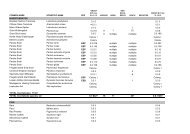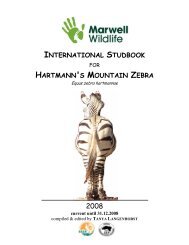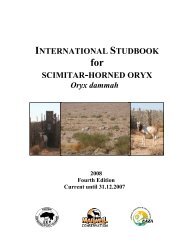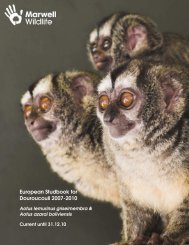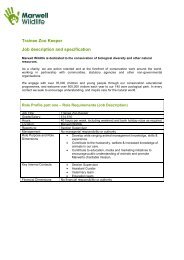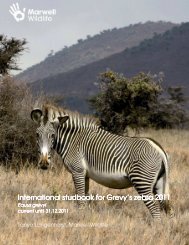Hartmann's mountain zebra studbook 2011 - Marwell Zoo
Hartmann's mountain zebra studbook 2011 - Marwell Zoo
Hartmann's mountain zebra studbook 2011 - Marwell Zoo
Create successful ePaper yourself
Turn your PDF publications into a flip-book with our unique Google optimized e-Paper software.
Gondwana Cañon Park (GCP)<br />
Background information about <strong>mountain</strong> <strong>zebra</strong> in GCP is available from ground counts but there are<br />
problems with estimating numbers in this way because of <strong>zebra</strong> escape behaviour in response to<br />
vehicles in broken terrain. Mark-recapture procedures, using known individuals identified over defined<br />
periods, can potentially overcome this problem and we carried out the first estimate of this kind in<br />
<strong>2011</strong>. We used four camera traps in the 30,000 ha northern, <strong>mountain</strong>ous part of the park in the dry<br />
season when most <strong>mountain</strong> <strong>zebra</strong> visit water holes every day. The ‘mark’ and ‘recapture’ periods<br />
were 6 days at the start of October and November respectively. The number of individuals identified<br />
in the first period was 73, in the second 220, and the number seen in both, 57. The difference<br />
between the two periods may have been because the camera installations had been improved at the<br />
start of the exercise and some <strong>zebra</strong>s had been deterred from approaching (<strong>mountain</strong> <strong>zebra</strong> are<br />
extremely cautious when approaching water if anything about the situation is unfamiliar). However,<br />
the difference in numbers should not affect the procedures and the estimate from these data was<br />
287+/-16 (+/-SE) <strong>mountain</strong> <strong>zebra</strong>s which yields a density of about 0.96 <strong>mountain</strong> <strong>zebra</strong>/ km 2 . The total<br />
number of individuals actually identified during the two sampling periods was 237. The fact that this is<br />
high relative to the estimate, plus the reasonably small error estimate, gives some confidence.<br />
It is hard to say what proportion of the northern population of GCP we sampled but bearing in mind<br />
how far and quickly <strong>mountain</strong> <strong>zebra</strong> move (which may enhance ‘re-mixing’ and thus the realism of the<br />
mark-recapture assumptions) it is probably over 80%. The <strong>2011</strong> estimate from road transects for the<br />
whole Park (which has recently been expanded to about 126,000 ha) was 367. The northern area has<br />
historically contained 85.4% of the <strong>mountain</strong> <strong>zebra</strong> seen in the Park, so the calculated number from<br />
the road transects count for comparison with the mark-recapture estimate is about 313. The estimates<br />
are quite close and give some confidence about population size and, thus, the remarkable increase in<br />
numbers that has occurred since the Park was established (see report in 2010 <strong>studbook</strong>).<br />
Mountain <strong>zebra</strong> breeding group drinking in Gondwana Cañon Park in December <strong>2011</strong> © Gosling<br />
The number obtained by enumeration of known individuals in <strong>2011</strong> (388) should be regarded as an<br />
indication of the ‘source population’ for the area. Because of their mobility, not all of these animals will<br />
be present in the area, or even in the Park, at any one time. In fact, it is quite surprising that the mark-<br />
AII





